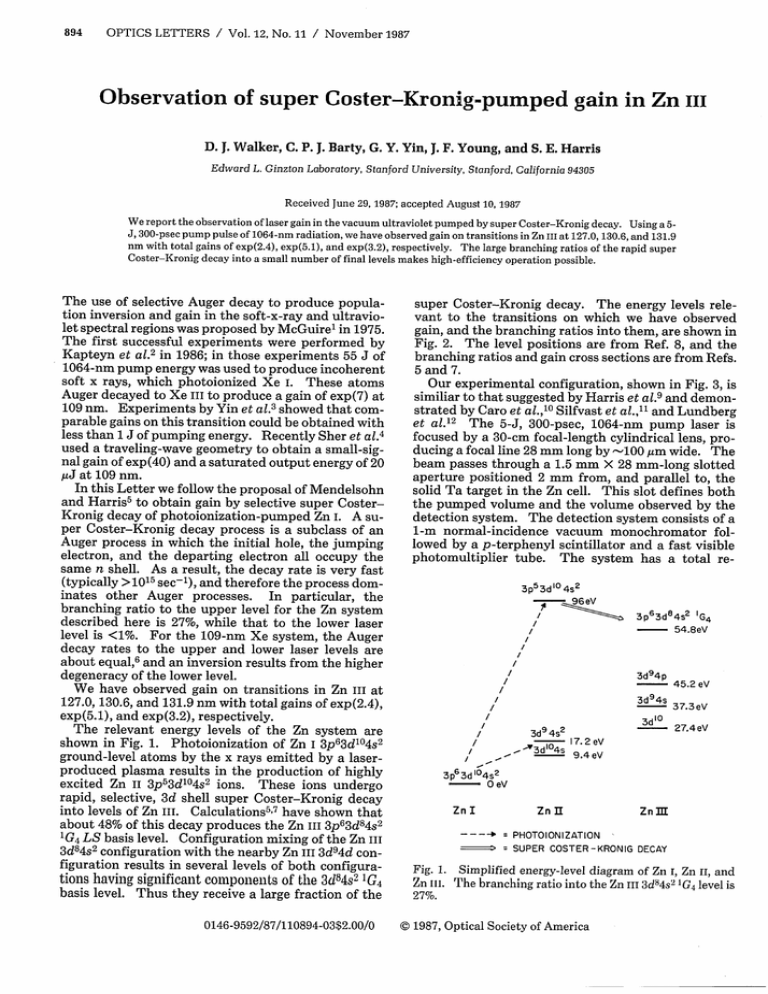Observation of Super Coster-Kronig
advertisement

894 OPTICS LETTERS / Vol. 12, No. 11 / November 1987 Observation of super Coster-Kronig-pumped gain in Zn III D. J. Walker, C. P. J. Barty, G. Y. Yin, J. F. Young, and S. E. Harris Edward L. Ginzton Laboratory, Stanford University, Stanford, California 94305 Received June 29, 1987; accepted August 10, 1987 We report the observation of laser gain in the vacuum ultraviolet pumped by super Coster-Kronig decay. Using a 5J, 300-psec pump pulse of 1064-nm radiation, we have observed gain on transitions in Zn II at 127.0, 130.6, and 131.9 nm with total gains of exp(2.4), exp(5.1), and exp(3.2), respectively. The large branching ratios of the rapid super Coster-Kronig decay into a small number of final levels makes high-efficiency operation possible. The use of selective Auger decay to produce population inversion and gain in the soft-x-ray and ultraviolet spectral regions was proposed by McGuire' in 1975. The first successful experiments were performed by Kapteyn et al.2 in 1986; in those experiments 55 J of 1064-nmpump energy was used to produce incoherent soft x rays, which photoionized Xe I. These atoms Auger decayed to Xe III to produce a gain of exp(7) at 109 nm. Experiments by Yin et al.3 showed that com- parable gains on this transition could be obtained with less than 1 J of pumping energy. Recently Sher et al.4 used a traveling-wave geometry to obtain a small-signal gain of exp(40) and a saturated output energy of 20 LJ at 109 nm. In this Letter we followthe proposal of Mendelsohn and Harris5 to obtain gain by selective super CosterKronig decay of photoionization-pumped Zn I. A su- per Coster-Kronig decay process is a subclass of an Auger process in which the initial hole, the jumping electron, and the departing electron all occupy the same n shell. As a result, the decay rate is very fast (typically >1015 sec-'), and therefore the process dominates other Auger processes. In particular, the branching ratio to the upper level for the Zn system described here is 27%, while that to the lower laser super Coster-Kronig decay. The energy levels relevant to the transitions on which we have observed gain, and the branching ratios into them, are shown in Fig. 2. The level positions are from Ref. 8, and the branching ratios and gain cross sections are from Refs. 5 and 7. Our experimental configuration, shown in Fig. 3, is similiar to that suggested by Harris et al.9 and demonstrated by Caro et al.,' 0 Silfvast et al.,"1 and Lundberg et al.12 The 5-J, 300-psec, 1064-nm pump laser is focused by a 30-cm focal-length cylindrical lens, producing a focal line 28 mm long by '100 ,m wide. The beam passes through a 1.5 mm X 28 mm-long slotted aperture positioned 2 mm from, and parallel to, the solid Ta target in the Zn cell. This slot defines both the pumped volume and the volume observed by the detection system. The detection system consists of a 1-m normal-incidence vacuum monochromator followed by a p-terphenyl scintillator and a fast visible photomultiplier tube. The system has a total re3p5 3d10 4s 2 -96eV / level is <1%. For the 109-nm Xe system, the Auger decay rates to the upper and lower laser levels are about equal,6 and an inversion results from the higher degeneracy of the lower level. We have observed gain on transitions 3p 6 3d8 4s2 G4 54.8eV - / / 3d9 4p in Zn III -d94p at 127.0, 130.6,and 131.9nm with total gains of exp(2.4), 3d-45 37.3eV exp(5.1), and exp(3.2), respectively. The relevant energy levels of the Zn system are shown in Fig. 1. Photoionization of Zn I 6 0 3p 3d' 4s 2 ground-level atoms by the x rays emitted by a laserproduced plasma results in the production of highly 5 0 / excited Zn II 3p 3d' 4s ions. These ions undergo rapid, selective, 3d shell super Coster-Kronig decay into levels of Zn III. Calculations5 ' 7 have shown that / Zn I about 48% of this decay produces the Zn III 3p6 3d84s2 1G LS basis level. Configuration mixing of the Zn III 4 3d8 4s2 configuration with the nearby Zn III 3d94d con- 0146-9592/87/110894-03$2.00/0 / / / -do27.4eV 3d9 4s 2 -3 .-- 3d4 17.2eV 9.4 eV - 3p6 3d104s2 - _ OeV 2 figuration results in several levels of both configurations having significant components of the 3d8 4s2 1G4 basis level. Thus they receive a large fraction of the 45.2 eV Zn H ZnE = PHOTOIONIZATION = SUPERCOSTER-KRONIGDECAY Simplified energy-level diagram of Zn I, Zn II, and Zn ill. The branching ratio into the Zn III 3d84s' 'G4 level is Fig. 1. 27%. © 1987, Optical Society of America November 1987 / Vol. 12, No. 11 / OPTICS LETTERS 27% 18% 2 3d84S IG4 9 221052 cm-l 1 3d 4d G4 219360cm1 7% 3d94d3G4 / S- 216464cm- . IC 1 S1 E E lE S a 1_ E , _ 1, 9 t 3 144501cm 3d 4p D3 9 3 3d 4p F3 l Fig. 2. Energy-level diagram of the transitions gain was observed. 1 140655 cm- on which We estimate our minimum measurable gain to be about 0.7 cm-'. The measured values varied about 20% from day to day, largely because of variations in the performance of the Zn cell. Figure 5 shows that the gain at 130.6nm maximizes at a Zn pressure of about 1.2 Torr. The decrease in gain at higher pressure is probably due to electron quenching of the upper-level population. In Zn I, the largest photoionization cross section is for the removal of a 3d electron, not a 3p electron.14 Thus a large number of electrons are produced that are not involved in creating excited states but that can act to destroy the inversion by processes such as electron deexcitation or ionization of the upper level. In addition to measuring the gain at 127.0, 130.6, and 131.9 nm, we also looked for gain at 130.3, 133.2, 135.9, and 136.3nm, using the 1.2-Torr optimum pressure. These transitions have upper levels that are populated by super Coster-Kronig decay and could conceivably have gain. We did not observe gain above our minimum threshold at any of these wavelengths. We note that the 133.2-nm transition, which shares an ERGET BEAM FOCUS 100 gm x 28 mm 500 400 TO ECTOR 300/ CYLINDRICAL LENS Fig. 3. a = ~~~1.7/ X Schematic of experimental 895 configurnition. - sponse time of about 5 nsec FWHM. The Zn cell is a heat-pipe oven with He buffer gas operating at about 5000C. Because the operating temperature Is so close to the melting point of Zn, 4180C, the heat-p ipe wicks are not effective in returning condensed Zn Ito the hot zone, and the cell has a tendency to deplete affterabout 1 h of operation. The Zn cell is separated from the spectrometer by a LiF window. The gains of the Zn transitions were meEisured by 200 100 0 0 1 3 2 Length (cm) Fig. 4. Output energy at 130.6 nm as a function of pumped length for a plasma-producing laser energy of 5 J in a 300psec pulse and Zn pressure of 1.2 Torr. blocking parts of the pump beam to vary the length of the pumping plasma and measuring the resu lting output energy. The actual output beam of our] laser is 32 mm in diameter, but 2 mm of each edge of the beam blocked to equalize the e rnergy per was permanently unit area of different vertical strips of the be am. The measured energy as a function of plasma l1ength was fitted to the theoretical frequency-integrated I emission function of a line radiator, which can be appr 'oximated as1 3 E [exp(al) - 113/2 [al exp(al)]' 12 (1) where a is the gain per unit length and 1 is the length. The points on Fig. 4 are measured values of 130.6-nm 0-0 I.. 0 energy, and the curve is the best fit of expression (1) to those points. In this case the fit indicates a = 1.7 cm 1 and a total gain of exp(4.8). This method was used to determine all the gain values presented here. 2 4 6 8 10 Pressure (torr) Fig. 5. Gain coefficient as a function of Zn pressure at 130.6 nm for a 5-J, 300-psec-longpump pulse. 896 OPTICS LETTERS / Vol. 12, No. 11 / November 1987 upper level with the 130.6-nm transition, was predicted5 to have the higher gain; we did not observe this to be the case. In summary, using only several joules of laser energy, we have observed super Coster-Kronig-pumped gain on several transitions near 130 nm. As shorterwavelength systems and deeper holes are reached, the high selectivity and ease of identification of the super Coster-Kronig process will make the process important not only for directly pumped systems but also for systems that are pumped by Auger cascade. The authors thank A. J. Mendelsohn for helpful discussions. P. J. Barty acknowledges the support of a U.S. Office of Naval Research Fellowship. This research was supported jointly by the U.S. Air Force Office of Scientific Research, the U.S. Army Research Office, the U.S. Office of Naval Research, Lawrence Livermore National Laboratory, and the Strategic Defense Initiative Organization. References 1. E. J. McGuire, Phys. Rev. Lett. 35, 844 (1975). 2. H. C. Kapteyn, R. W. Lee, and R. W. Falcone, Phys. Rev. Lett. 57, 2939 (1986). 3. G. Y. Yin, C. P. J. Barty, D. A. King, D. J. Walker, S. E. Harris, and J. F. Young, Opt. Lett. 12, 331 (1987). 4. M. H. Sher, J. J. Macklin, J. F. Young, and S. E. Harris, Opt. Lett. 12, 891 (1987). 5. A. J. Mendelsohn and S. E. Harris, Opt. Lett. 10, 128 (1985). 6. H. C. Kapteyn, M. M. Murnane, R. W. Falcone, G. Kolbe, and R. W. Lee, Proc. Soc. Photo-Opt. Instrum. Eng. 688, 54 (1986). 7. A. J. Mendelsohn, "Extreme ultraviolet emission spectroscopy of atoms and laser applications," Ph. D. dissertation (Stanford University, Stanford, Calif., 1985). 8. K. A. Dick, Can. J. Phys. 46, 1291 (1968). 9. S. E. Harris, J. F. Young, R. W. Falcone, J. E. Rothen- berg, J. R. Willison, and J. C. Wang, in Laser Techniques for Extreme Ultraviolet Spectroscopy, T. J. McIlrath and R. R. Freeman, eds. (American Institute of Physics, New York, 1982), pp. 137-152. 10. R. G. Caro, J. C. Wang, R. W. Falcone, J. F. Young, and S. E. Harris, Appl. Phys. Lett. 42, 9 (1983). 11. W. T. Silfvast, J. J. Macklin, and 0. R. Wood II, Opt. Lett. 8, 551 (1983). 12. H. Lundberg, J. J. Macklin, W. T. Silfvast, and 0. R. Wood II, Appl. Phys. Lett. 45, 335 (1984). 13. G. J. Linford, E. R. Peressini, W. R. Sooy, and M. L. Spaeth, Appl. Opt. 13, 379 (1974). 14. A. W. Fliflet and H. P. Kelley, Phys. Rev. A 13, 312 (1976).



